翻译理论论文
彼得.纽马克的翻译理论初探
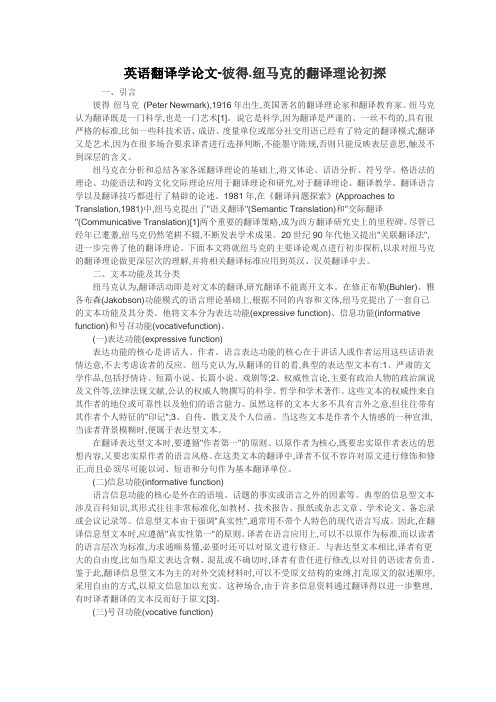
英语翻译学论文-彼得.纽马克的翻译理论初探一、引言彼得·纽马克(Peter Newmark),1916年出生,英国著名的翻译理论家和翻译教育家。
纽马克认为翻译既是一门科学,也是一门艺术[1]。
说它是科学,因为翻译是严谨的、一丝不苟的,具有很严格的标准,比如一些科技术语、成语、度量单位或部分社交用语已经有了特定的翻译模式;翻译又是艺术,因为在很多场合要求译者进行选择判断,不能墨守陈规,否则只能反映表层意思,触及不到深层的含义。
纽马克在分析和总结各家各派翻译理论的基础上,将文体论、话语分析、符号学、格语法的理论、功能语法和跨文化交际理论应用于翻译理论和研究,对于翻译理论、翻译教学、翻译语言学以及翻译技巧都进行了精辟的论述。
1981年,在《翻译问题探索》(Approaches to Translation,1981)中,纽马克提出了"语义翻译"(Semantic Translation)和"交际翻译"(Communicative Translation)[1]两个重要的翻译策略,成为西方翻译研究史上的里程碑。
尽管已经年已耄耋,纽马克仍然笔耕不辍,不断发表学术成果。
20世纪90年代他又提出"关联翻译法",进一步完善了他的翻译理论。
下面本文将就纽马克的主要译论观点进行初步探析,以求对纽马克的翻译理论做更深层次的理解,并将相关翻译标准应用到英汉、汉英翻译中去。
二、文本功能及其分类纽马克认为,翻译活动即是对文本的翻译,研究翻译不能离开文本。
在修正布勒(Buhler)、雅各布森(Jakobson)功能模式的语言理论基础上,根据不同的内容和文体,纽马克提出了一套自己的文本功能及其分类。
他将文本分为表达功能(expressive function)、信息功能(informative function)和号召功能(vocativefunction)。
翻译学术论文摘要模版
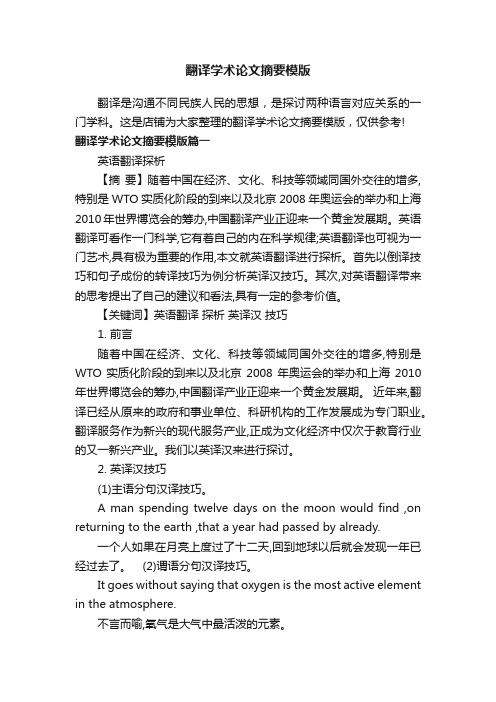
翻译学术论文摘要模版翻译是沟通不同民族人民的思想,是探讨两种语言对应关系的一门学科。
这是店铺为大家整理的翻译学术论文摘要模版,仅供参考!翻译学术论文摘要模版篇一英语翻译探析【摘要】随着中国在经济、文化、科技等领域同国外交往的增多,特别是WTO实质化阶段的到来以及北京2008年奥运会的举办和上海2010年世界博览会的筹办,中国翻译产业正迎来一个黄金发展期。
英语翻译可看作一门科学,它有着自己的内在科学规律;英语翻译也可视为一门艺术,具有极为重要的作用,本文就英语翻译进行探析。
首先以倒译技巧和句子成份的转译技巧为例分析英译汉技巧。
其次,对英语翻译带来的思考提出了自己的建议和看法,具有一定的参考价值。
【关键词】英语翻译探析英译汉技巧1. 前言随着中国在经济、文化、科技等领域同国外交往的增多,特别是WTO实质化阶段的到来以及北京2008年奥运会的举办和上海2010年世界博览会的筹办,中国翻译产业正迎来一个黄金发展期。
近年来,翻译已经从原来的政府和事业单位、科研机构的工作发展成为专门职业。
翻译服务作为新兴的现代服务产业,正成为文化经济中仅次于教育行业的又一新兴产业。
我们以英译汉来进行探讨。
2. 英译汉技巧(1)主语分句汉译技巧。
A man spending twelve days on the moon would find ,on returning to the earth ,that a year had passed by already.一个人如果在月亮上度过了十二天,回到地球以后就会发现一年已经过去了。
(2)谓语分句汉译技巧。
It goes without saying that oxygen is the most active element in the atmosphere.不言而喻,氧气是大气中最活泼的元素。
(3)定语分句汉译技巧He managed to raise a crop of 200 miracle tomatoes that wEighed up to two pounds each.他居然种出了二百个奇迹般的西红柿,每个重达两磅。
发表英文翻译论文

发表英文翻译论文语言是人类传播信息的工具,作为各种语言互译的翻译理论本身就是一种是相对的理论。
下文是店铺为大家整理的关于发表英文翻译论文的范文,欢迎大家阅读参考!发表英文翻译论文篇1公示语的英文翻译摘要:公示语是一种较为独特的应用文体, 旨在于公共场所向公众公示须知的内容。
然而, 目前国内公示语的英译问题十分严重。
通过奈达的"功能对等"理论, 以中西文化差异在公示语中的体现为视角, 强调公示语的特点决定了其英译应重视功能上的对等而不是字词句上简单生硬的静态对等, 遵循正确的翻译原则,以实现公示语的预期功能。
关键词:公示语功能对等文化差异翻译原则1、引言公示语指的是在公共场所向公众公示须知内容的语言, 包括标识、指示牌、路牌、标语、公告、警示等等[1]。
罗选民、黎土旺对公示语进行界定, “公示语是指在公共场合所展示的文字, 具有特殊的交际功能, 以及提供信息和完成指令的作用”[2]。
随着中国与世界的接轨, 越来越多的国家希望了解中国, 很多外国朋友来到中国。
在这种跨文化交际的过程中, 汉语公示语的英译也日显重要。
然而, 目前国内公示语的英译问题十分严重, 误用、滥用现象到处存在,其中最大的问题是译者在翻译过程中忽视中西方文化的差异, 盲目追求字词句上简单生硬的静态对等, 以至于译文文本生硬, 达不到源语文本的预期功能和效果。
公示语英译的预期对象是在华外国友人和外国游客, 为的是达到向其警示、告知、宣传的预期功能。
其英译不是一种点缀, 而是一种有目的的行为, 即如何使译文达到与原文本同等的预期功能[3]。
本文通过奈达的“功能对等”理论, 以中西文化差异在公示语中的体现为视角, 强调公示语的功能特点决定了其英译应重视功能上的对等而不是字词句上简单生硬的静态对等, 应遵循正确的翻译原则,以实现其预期功能。
2、“功能对等”翻译理论与公示语翻译公示语作为一个信息时代和经济全球化时代的标志之一, 公开面对公众, 给予公众行为需求的文字信息传递。
有关英汉翻译论文

有关英汉翻译论文范文一:生态学视域下的英汉翻译一、引言:英汉翻译研究生态学视域的成立生态学是研究物质与周围环境关系的一门科学,其发轫之初很长时间里被用于自然科学研究。
而随着生态学的发展和交叉、跨学科研究日趋成熟,社会科学的研究者们发现了生态学与人文社会科学的相容性,认为人文社会领域和自然一样,事物与事物、事物与环境间都发生着联系,没有独立于环境之外的事物和现象,故而认为生态学研究的理论、方法同样适用于社会科学研究。
生态学研究与社会科学研究遂真正结合起来。
20世纪50年代以来,人们对文本的认识由仅仅关注认识文本内部自足性问题发展到研究文本内外部关联问题,研究的视野也随之由微观文字向宏观文化转向,人们对文本的认识,已无法将文本语言与该语言所蕴含或显现的某国或某民族的文化相割断。
对于成功的翻译者来说,他不仅要作为两种语言的专家,还要是两种语言各自代表的文化的熟知者。
对于英汉翻译的研究者来说,他们需要不断探寻着解释原文本与译文本之间形成文化差异的依据———这些依据就是社会各层面因素影响文本文字的关系。
生态学强调事物与其环境协调、互动、互相促进。
在英汉翻译领域,一个成功或优秀的译作应当是不仅内部自足和谐发展,而且内部与外部互惠互利、共生共栖的文本。
其动态性体现在这种交互作用是永无止息、不断旋螺式发展的,而非一成不变或者无意义的重复。
用生态学视角看待英汉翻译,为的是建立一种整体性思维。
有学者为“整体性”的意义进行了阐释:“整体性是生命的基本属性,整体性不是部分的简单累加,也不是由外力推动而形成的原子集合体,它有着超越部分之和的更为丰富的内涵和属性。
”对翻译及其研究工作来说,把握“整体性”是关键。
翻译活动涵盖原文本和译文本,涉及原文作者、译者、译文读者3方,包括语言和文化2个层面,同时受到政治环境、经济环境、主流意识形态等的影响。
梳理和廓清这些形成翻译活动的要素的动态平衡发展,有助于建构英汉翻译研究的生态学视域。
翻译理论论文-郭沫若创造性

一、郭沫若译著简介郭沫若的译作覆盖面广,包括戏剧、小说、诗歌、文艺理论、马列著作与科技作品等不同体裁。
他精通日、德、英等国文字,译作颇为丰富。
代表译作有歌德的《浮士德》(上卷1928年,下卷1947 年) 、《少年维特之烦恼》(1922 年)、雪莱《雪莱诗选》(1926 年)马克思《政治经济学批判》(1931 年)、马克思恩格斯合著《德意志意识形态》(1931 年)等。
在翻译的选材上,郭沫若非常注意作品的时代性,总是选择与自身生活时代极为相似的作品作为折射。
郭沫若选译的原著大多深刻反映下层人物的悲惨遭遇,对社会下层人物寄予了深厚同情的作品,借以揭露和控诉黑暗的旧制度和吃人的剥削社会;符合当时读者渴望自由平等、要求个性解放的思潮,宣扬平等自由,号召反帝反封建,打碎旧世界,建立新社会。
也与他本人具有的反抗性浪漫主义精神紧相吻合。
加以他深厚的中文功底,因此译来有如神助。
他的文学译品,尤其是译诗,大多具有很强的魅力,能够拨动读者的心弦(《中国翻译词典》257 页)。
德国著名诗人歌德的作品都具有强烈的政治倾向性,揭露和批判了封建制度的腐朽,宣扬个性解放和自由平等,这些激进的思想在郭沫若心里引起了强烈的共鸣。
他选择翻译歌德的《浮士德》,是认为当时中国的五四运动很像歌德青年时代的狂飙突进运动,是由封建社会向现代社会急变的历史转折时期,是反对封建束缚和专制暴政、要求个性解放的思想文化运动。
20 世纪20 年代前期,浪漫主义对我国文坛影响巨大。
郭沫若是受惠特曼影响最大的中国现代诗人,曾被称为“中国的惠特曼”。
惠特曼对民主自由的追求,对个性解放和自我的张扬,对劳动人民的赞美,对未来的乐观主义的信念,都是和“五四”前后的时代精神,和当时进步知识分子的革命要求相适应的。
郭沫若是新文学积极浪漫主义的主将,他的译论自然也带有这一色彩。
然而,受他当时文艺思想中宗派主义和唯心主义成分的影响,郭沫若的翻译理论也含有这样一些消极因素。
浅析奈达的翻译理论

浅析奈达的翻译理论摘要:本篇文章首先阐述奈达不同阶段的翻译理论,再分析奈达在翻译理论方面的贡献和成就,探究奈达翻译理论中的缺陷,希望可以为相关的研究工作者提供一定的参考建议,进一步了解奈达的翻译理论。
关键词:奈达;翻译理论引言:尤金奈达博士是当代西方最著名的翻译理论家和语言学家之一。
奈达博士通过50多年的实践和翻译理论研究,在翻译研究领域取得了巨大成就。
其发展大致可分为三个阶段:描写语言学阶段、交际阶段和符号学阶段。
20世纪80年代初,美国翻译理论传入中国,人们主要关注中国传统的翻译理论,尤其是严复的三字翻译标准,即信、达、雅。
自从奈达的美国翻译理论被传入中国后,一些中国的翻译研究学者便对此研究产生了极大浓厚的兴趣。
究其原因,是在于他创建的新翻译理论系建立于当代应用语言学、传播学、信息论、符号学、人类学研究的整体发展水平基础上,摆脱掉了许多以往传统翻译理论系研究方法中缺乏的研究经验,第一次系统地使现代翻译理论的研究工作达到了其某种特定意义基础上特有的科学性。
尤其是他首创的翻译理论动态分析对等于翻译理论标准读者的等效反应理论突破了中国静态翻译分析理论的固有研究理论范式,并提出了开放式的静态翻译分析理论实证研究,为引导我们逐步建立一套新时期的动态翻译研究理论模式体系提供了许多很有益处的新启示。
1.奈达不同阶段的翻译理论分析奈达在20世纪40、50年代阶段的著作文章和会议论文写作,主要系统地结合现代翻译理论并从语言中的译词法理论和译句法方面深入阐述揭示了翻译语言的本质意义和语际翻译转化关系,试图由此找出一些更基本科学有效的现代语言翻译及其转换规律。
他提出的语言等级理论在这个历史阶段可能要远远比乔姆斯基理论早出现得。
第二阶段历时为10年多(1959-1969)。
标志着翻译第二阶段真正开始的理论文章之一是由他自己在1959年翻译出版过的专著《从圣经的翻译看翻译原则》,标志着翻译第二阶段正式结束的一书即是由他本人和泰伯合著翻译的专著《翻译理论与实践》。
翻译理论论文

翻译理论基础学习收获一、翻译理论背景1.1 翻译学学科历史翻译实践活动的历史和人类文明的历史一样长久,西方翻译最早开始于公元三世纪,距今已有两千多年的历史。
作为文明古国的中国的翻译历史和西方一样悠久。
但由于对于翻译活动的认识存在诸多悖论,达不成一致意见,人们因追求所谓严整的体系、规范的术语而将历史上对翻译的传统认识排斥在理论之外,认为翻译学作为一门独立的研究学科才不过50多年的历史。
1972年,詹姆斯.霍尔姆斯(James S.Holmes,美国人)在哥本哈根第三届国际应用语言学大会上宣读了《The name and nature of translation studies》(翻译学的名称和性质),这篇论文被普遍认为是翻译学科建设的奠基之作。
对研究翻译的人来说,传统的翻译理论也应该受到一定的关注。
1.2 翻译学学科框架在《The name and nature of translation studies》中,霍尔姆斯将翻译研究领域的名称命名为“translation studyies”,并勾画出了一套系统的翻译研究框架,图里(Toury,1995:10)将其绘制成下图,广为学界引用:图1 翻译学学科框架图在该架构中,翻译学的各个领域彼此之间相互联系,相互作用。
霍尔姆斯的翻译学框架图被视作翻译学作为独立学科建立的标志。
二、语言2.1语言和言语什么是语言?语言是人类所特有的用来表达意思、交流思想的工具,是人们进行沟通交流的各种表达符号系统,它是一种特殊的社会现象,是民族的重要特征之一,由语音、词汇和语法构成一定的系统。
符合随着社会历史的发展可变可塑,不是固定恒定的信号。
什么是言语?言语是人们利用语言进行交际的行为和结果,它是个人的意志和智能的行为和结果。
人们说话包括以下三个方面:(1)张口说话的动作,即“说话”的动作、行为,我们称之为言语动作和言语行为。
(2)说话所使用的一套符号,“说话所使用的词语、规则”。
中西翻译理论的差异性比较及其启示_外语翻译

中西翻译理论的差异性比较及其启示_外语翻译外语翻译[论文摘要]本文从中西方翻译理论的差异性比较入手,从其差异性产生的原因、具体表现、差异性比较的意义、中国的对策和中国传统译论的继承和发扬等五个方面进行差异性比较研究,明晰中西翻译理论的各自侧重和不同,借鉴西方翻译理论的优点,有利于我国翻译事业的发展。
翻译作为不同语言之间人们交流沟通的工具,无论在中国还是在西方,都有着悠久的历史。
我国的翻译事业迄今已有近两千年的光辉灿烂历史。
一般认为,有历史记载的中国翻译始于东汉桓帝建和二年(公元148年)的佛经翻译。
而且自此之后,产生了四大翻译高潮时期,并产生了许多杰出的翻译家。
西方最早的译作是在公元前3世纪前后,72名犹太学者在埃及亚历大城翻译了《圣经旧约》,即《七十子希腊文本圣经》。
因此可以说,西方的翻译活动至今已有两千三百多年的历史了。
期间,西方的翻译在历史上曾经出现过六次高潮。
随着时间的发展,特别是到了近现代,西方的翻译论理和流派日益科学化和系统化,处于领先的地位。
一、中西译论差异的原因探究中西翻译的历史同样悠久,并都有着丰硕的成果,但是中国的传统翻译理论与西方的翻译理论比较起来显得相对滞后。
本文对中国的传统翻译理论与西方的翻译理论比较起来相对滞后的原因做出分析:第一、历史原因。
在第二次世界大战之后,西方翻译事业发展的形式有了很大的变化和进步。
与此同时,中国从二战结束后到改革开放前期这一段时间里,翻译事业乃至各项事业发展的大环境是封闭的,是停滞不前的,这与同时期突飞猛进的西方翻译是远不能相比的,差距由此拉开。
其次,中国的思维方式也是造成中国传统翻译理论相对滞后的原因。
中国人的传统思维习惯重综合,西方人的传统思维习惯重分析。
表现在翻译理论上面,中国传统翻译理论大都是经验式的总结,其中很大程度上是主观感受。
而西方的翻译理论大多都是成理论体系的,体现了较强的科学主义精神。
在当今重视科学理论和实践相结合的时代,中国的传统翻译理论与西方翻译理论相比自然显得相对滞后。
翻译方向论文

AcknowledgementsThis thesis has taken me almost half a year to turn it from conception to the final completion。
A number of people have been wonderfully helpful in my doing research as well as completing the thesis. So I especially wish to acknowledge the following people。
First of all,I would like to express my heartfelt appreciation to my supervisor Liu Yanfen for her long and lasting patient and constructive instructions on my thesis writing.Secondly,my many thanks also go to my Translation Teacher Ms Qiao who let me have an interest in Translation.Thirdly, I would like to thank all the teachers who teach me and give me help.At last, my thanks go to my roommates who give me confidence to accomplishing this thesis。
AbstractTranslation is a communicative activity. The Functionalist Approaches give a definition that translating is a purposeful activity。
庞德----翻译理论论文
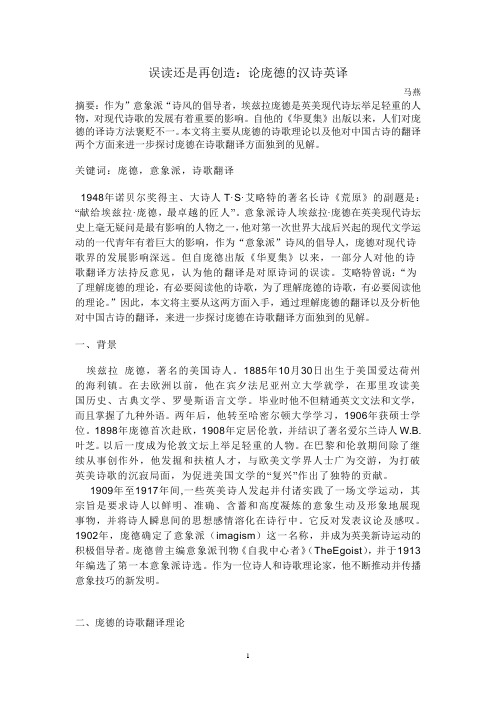
误读还是再创造:论庞德的汉诗英译-------马燕摘要:作为”意象派“诗风的倡导者,埃兹拉庞德是英美现代诗坛举足轻重的人物,对现代诗歌的发展有着重要的影响。
自他的《华夏集》出版以来,人们对庞德的译诗方法褒贬不一。
本文将主要从庞德的诗歌理论以及他对中国古诗的翻译两个方面来进一步探讨庞德在诗歌翻译方面独到的见解。
关键词:庞德,意象派,诗歌翻译1948年诺贝尔奖得主、大诗人T·S·艾略特的著名长诗《荒原》的副题是:“献给埃兹拉·庞德,最卓越的匠人”。
意象派诗人埃兹拉·庞德在英美现代诗坛史上毫无疑问是最有影响的人物之一,他对第一次世界大战后兴起的现代文学运动的一代青年有着巨大的影响,作为“意象派”诗风的倡导人,庞德对现代诗歌界的发展影响深远。
但自庞德出版《华夏集》以来,一部分人对他的诗歌翻译方法持反意见,认为他的翻译是对原诗词的误读。
艾略特曾说:“为了理解庞德的理论,有必要阅读他的诗歌,为了理解庞德的诗歌,有必要阅读他的理论。
”因此,本文将主要从这两方面入手,通过理解庞德的翻译以及分析他对中国古诗的翻译,来进一步探讨庞德在诗歌翻译方面独到的见解。
一、背景埃兹拉庞德,著名的美国诗人。
1885年10月30日出生于美国爱达荷州的海利镇。
在去欧洲以前,他在宾夕法尼亚州立大学就学,在那里攻读美国历史、古典文学、罗曼斯语言文学。
毕业时他不但精通英文文法和文学,而且掌握了九种外语。
两年后,他转至哈密尔顿大学学习,1906年获硕士学位。
1898年庞德首次赴欧,1908年定居伦敦,并结识了著名爱尔兰诗人W.B.叶芝。
以后一度成为伦敦文坛上举足轻重的人物。
在巴黎和伦敦期间除了继续从事创作外,他发掘和扶植人才,与欧美文学界人士广为交游,为打破英美诗歌的沉寂局面,为促进美国文学的“复兴”作出了独特的贡献。
1909年至1917年间,一些英美诗人发起并付诸实践了一场文学运动,其宗旨是要求诗人以鲜明、准确、含蓄和高度凝炼的意象生动及形象地展现事物,并将诗人瞬息间的思想感情溶化在诗行中。
(论文)论翻译的原则-外语翻译1_070425121009

(论文)论翻译的原则-外语翻译摘要:抽象的标准如“善译”和“化境”是不可实现的理想,与其取法不可实现的理想,毋宁提出切实具体的要求作为翻译的基本原则:1)信守原文的内容意旨;2)遵从译语的语言习惯;3)切合原文的语体语域。
关键词:信守内容意旨;遵从译语习惯;切合语体语域Abstract: Transmigration, an abstract whole at large, is too good to be practical and such concrete subwholes und er “good translation” as fidelity to the source-language text in content and intention, grammatical normality, and lexical appropriateness are more workable as cardinal principles of translation.Key words: fidelity; grammatical normality; lexical appropriateness翻译是把一种语言文字所表达的意义用另一种语言文字表达出来,具体说来,就是“换易言语使相解也”。
①但是,如何用另一种语言文字把一种语言文字所表达的意义表达出来?“换易言语”之后是否能“相解”?“相解”的程度如何?这些问题归结起来无疑就是:翻译的标准是什么?翻译的方法应如何?严复是中国近代第一位系统介绍西方学术的启蒙思想家,在介绍西学的同时提出了翻译的标准—“信、达、雅”,对中国现代的翻译实践和理论研究影响巨大,“相信只要中国还有翻译,总还会有人念…三字经‟!”②虽然严复持论有故,但认真审视不难发现,“信、达、雅”实质上既不是具有高度概括力的抽象标准,也不是具有切实指导性的具体标准,“从纯理论的角度讲,把信、达、雅并列起来作为翻译标准是具有逻辑缺陷的,因为这似乎意味着:原文不达,也可以故意使之…达‟;原文不雅,也可以故意使之…雅‟。
翻译中的文本分析理论及其案例分析_英语论文
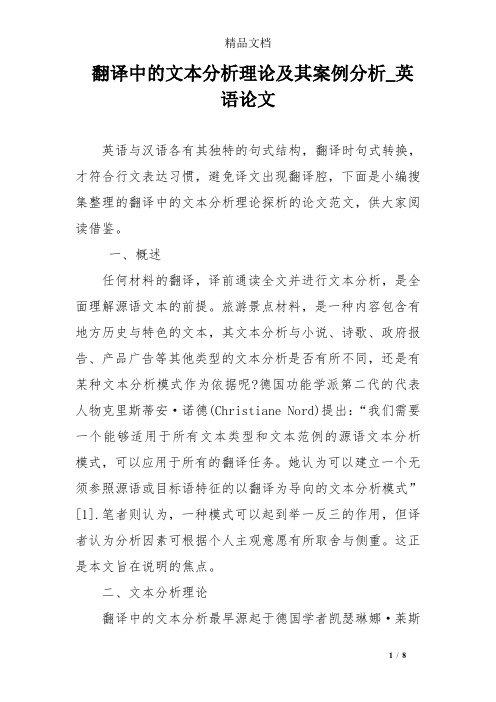
翻译中的文本分析理论及其案例分析_英语论文英语与汉语各有其独特的句式结构,翻译时句式转换,才符合行文表达习惯,避免译文出现翻译腔,下面是小编搜集整理的翻译中的文本分析理论探析的论文范文,供大家阅读借鉴。
一、概述任何材料的翻译,译前通读全文并进行文本分析,是全面理解源语文本的前提。
旅游景点材料,是一种内容包含有地方历史与特色的文本,其文本分析与小说、诗歌、政府报告、产品广告等其他类型的文本分析是否有所不同,还是有某种文本分析模式作为依据呢?德国功能学派第二代的代表人物克里斯蒂安·诺德(Christiane Nord)提出:“我们需要一个能够适用于所有文本类型和文本范例的源语文本分析模式,可以应用于所有的翻译任务。
她认为可以建立一个无须参照源语或目标语特征的以翻译为导向的文本分析模式”[1].笔者则认为,一种模式可以起到举一反三的作用,但译者认为分析因素可根据个人主观意愿有所取舍与侧重。
这正是本文旨在说明的焦点。
二、文本分析理论翻译中的文本分析最早源起于德国学者凯瑟琳娜·莱斯(Katharina Reiss)、费米尔(Hans Vermeer)创建的德国翻译功能理论及莱斯的功能文本类型理论。
在语言学家布勒语言功能三分法的基础上,莱斯把语言功能与文本联系起来,根据交际功能范畴把文本划分为:信息功能(informative),表达功能(expressive),感召功能(operative)三大文本类型[2].在篇章语言学和文本类型理论基础上,诺德提出了翻译的文本分析模式,旨在为译者提供一个分析源语文本的模式,运用于所有的文本类型和翻译过程。
诺德的翻译导向的文本分析模式强调对源文本的充分理解和准确阐释,解释语言、文本结构及源语言系统规范的关系,为译者选择翻译决策提供可靠的基础[3].相对语篇结构语言学派的文本结构分析,诺德的文本分析模式更为详细全面,对源语文本中的文内外因素进行分析。
诺德将源文本中的语言和非语言因素分为“文外因素”和“文内因素”,文外因素包括发送者、发送者意图、接受者、媒介、交际地点、交际时间、交际动机、文本功能八个方面。
翻译实践报告毕业论文

翻译实践报告毕业论文在大学生活的最后一年,我选择了进行一项研究项目——翻译实践报告毕业论文。
这个项目既是对我所学的翻译理论知识的应用与实践,也是对我个人英语水平和翻译能力的一次考验。
研究的主题是文学翻译中的文化转译。
我选取了一篇中国现代散文作品进行翻译,并将其中的文化元素转译成目标文化的表达方式。
在这个过程中,我深刻体会到了翻译的复杂性和挑战性。
首先,对于文学作品的翻译来说,最重要的是准确传递原文中的思想和情感。
在进行翻译时,我不仅要理解作者的用词和句法结构,还要理解作者的创作意图和文化背景。
只有在全面理解原文的基础上,我才能准确地传达作者的思想和情感。
其次,文学作品中常常涉及到文化元素,如习俗、传统、历史背景等。
在翻译过程中,我不仅要将原文的文化元素转译成目标文化的表达方式,还要确保转译后的表达方式能在目标文化中传达相同的意义和情感。
这就要求我对目标文化有深入的了解,以便选择适当的表达方式。
此外,对于文学作品的翻译来说,语言风格和文体的保持也至关重要。
每个作家都有独特的写作风格和文体,这是他们艺术创作的重要特征。
在翻译时,我要尽力保持原文的语言风格和文体,使读者能够感受到作者的独特魅力。
在进行翻译实践的过程中,我遇到了许多困难和挑战。
首先,文学作品的表达方式往往是抽象而隐喻的,这给翻译带来了很大的困难。
我需要将作者的抽象形象和隐喻意义准确地转译成目标文化的具体形象和意义,这要求我有较高的语言驾驭能力和创造力。
其次,文学作品的翻译需要一定的决策能力。
在翻译过程中,我常常面临多种表达方式的选择。
我需要在准确传达原文意义的基础上,考虑目标读者的接受能力和审美观点,并选择最合适的表达方式。
这就要求我有较好的语言判断和决策能力。
最后,在翻译实践中我也收获了很多。
通过与教授和同学的讨论和反思,我对翻译理论有了更深入的了解,并提高了自己的翻译能力。
我也学会了在短时间内高效地组织和完成一项大型翻译项目,这对我今后的工作和学习都有很大的帮助。
关于英语翻译方向的论文范文
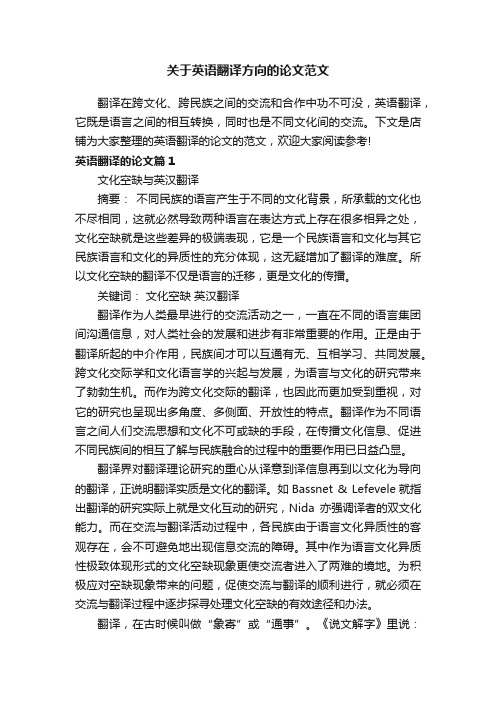
关于英语翻译方向的论文范文翻译在跨文化、跨民族之间的交流和合作中功不可没,英语翻译,它既是语言之间的相互转换,同时也是不同文化间的交流。
下文是店铺为大家整理的英语翻译的论文的范文,欢迎大家阅读参考!英语翻译的论文篇1文化空缺与英汉翻译摘要:不同民族的语言产生于不同的文化背景,所承载的文化也不尽相同,这就必然导致两种语言在表达方式上存在很多相异之处,文化空缺就是这些差异的极端表现,它是一个民族语言和文化与其它民族语言和文化的异质性的充分体现,这无疑增加了翻译的难度。
所以文化空缺的翻译不仅是语言的迁移,更是文化的传播。
关键词:文化空缺英汉翻译翻译作为人类最早进行的交流活动之一,一直在不同的语言集团间沟通信息,对人类社会的发展和进步有非常重要的作用。
正是由于翻译所起的中介作用,民族间才可以互通有无、互相学习、共同发展。
跨文化交际学和文化语言学的兴起与发展,为语言与文化的研究带来了勃勃生机。
而作为跨文化交际的翻译,也因此而更加受到重视,对它的研究也呈现出多角度、多侧面、开放性的特点。
翻译作为不同语言之间人们交流思想和文化不可或缺的手段,在传播文化信息、促进不同民族间的相互了解与民族融合的过程中的重要作用已日益凸显。
翻译界对翻译理论研究的重心从译意到译信息再到以文化为导向的翻译,正说明翻译实质是文化的翻译。
如Bassnet & Lefevele就指出翻译的研究实际上就是文化互动的研究,Nida亦强调译者的双文化能力。
而在交流与翻译活动过程中,各民族由于语言文化异质性的客观存在,会不可避免地出现信息交流的障碍。
其中作为语言文化异质性极致体现形式的文化空缺现象更使交流者进入了两难的境地。
为积极应对空缺现象带来的问题,促使交流与翻译的顺利进行,就必须在交流与翻译过程中逐步探寻处理文化空缺的有效途径和办法。
翻译,在古时候叫做“象寄”或“通事”。
《说文解字》里说:“传译四夷之言者。
”《义疏》里也提到:“译即易,谓换易言语使相解也。
英语翻译论文
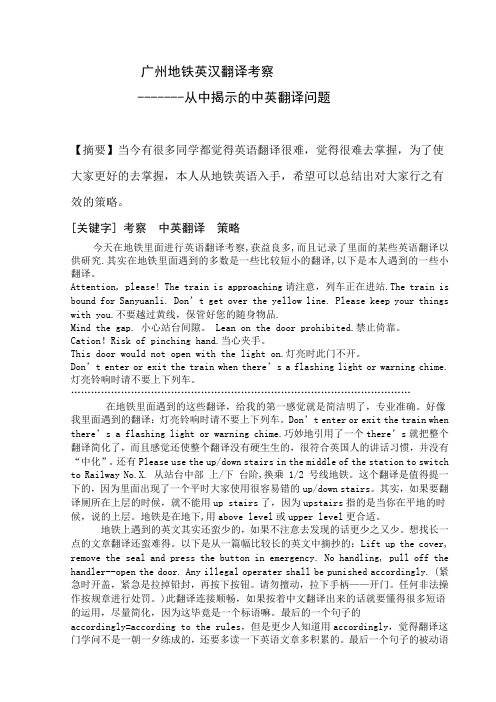
广州地铁英汉翻译考察-------从中揭示的中英翻译问题【摘要】当今有很多同学都觉得英语翻译很难,觉得很难去掌握,为了使大家更好的去掌握,本人从地铁英语入手,希望可以总结出对大家行之有效的策略。
[关键字] 考察中英翻译策略今天在地铁里面进行英语翻译考察,获益良多,而且记录了里面的某些英语翻译以供研究.其实在地铁里面遇到的多数是一些比较短小的翻译,以下是本人遇到的一些小翻译。
Attention, please! The train is approaching请注意,列车正在进站.The train is bound for Sanyuanli. Don’t get over the yellow line. Please keep your things with you.不要越过黄线,保管好您的随身物品.Mind the gap. 小心站台间隙。
Lean on the door prohibited.禁止倚靠。
Cation!Risk of pinching hand.当心夹手。
This door would not open with the light on.灯亮时此门不开。
Don’t enter or exit the train when there’s a flashing light or warning chime.灯亮铃响时请不要上下列车。
…………………………………………………………………………………………在地铁里面遇到的这些翻译,给我的第一感觉就是简洁明了,专业准确。
好像我里面遇到的翻译:灯亮铃响时请不要上下列车。
Don’t enter or exit the train when there’s a flashing light or warning chime.巧妙地引用了一个there’s就把整个翻译简化了,而且感觉还使整个翻译没有硬生生的,很符合英国人的讲话习惯,并没有“中化”。
归化和异化翻译理论论文(英语版)
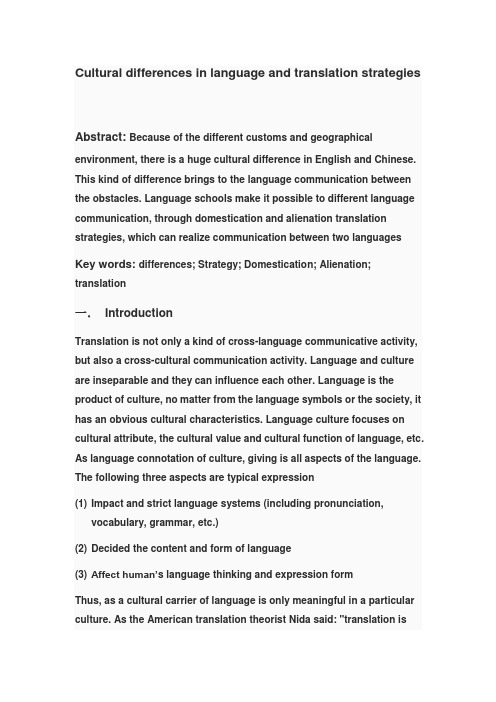
Cultural differences in language and translation strategiesAbstract:Because of the different customs and geographical environment, there is a huge cultural difference in English and Chinese. This kind of difference brings to the language communication between the obstacles. Language schools make it possible to different language communication, through domestication and alienation translation strategies, which can realize communication between two languagesKey words: differences; Strategy; Domestication; Alienation; translation一.IntroductionTranslation is not only a kind of cross-language communicative activity, but also a cross-cultural communication activity. Language and culture are inseparable and they can influence each other. Language is the product of culture, no matter from the language symbols or the society, it has an obvious cultural characteristics. Language culture focuses on cultural attribute, the cultural value and cultural function of language, etc. As language connotation of culture, giving is all aspects of the language. The following three aspects are typical expression(1) Impact and strict language systems (including pronunciation,vocabulary, grammar, etc.)(2) Decided the content and form of language(3) Affect human’s language thinking and expression formThus, as a cultural carrier of language is only meaningful in a particular culture. As the American translation theorist Nida said: "translation isthe communication between the two cultures. For truly successful translating, familiar with two cultures is even more important than to master two languages.” there is a huge difference in Chinese-English nationality values, beliefs, customs, historical background, geographical conditions, social system, life experience, etc. This difference not only imprint their respective language but also bring many difficulties for the mutual translation between the two languages. This article start from the cultural differences of Chinese-English, try to seek the cultural equivalence translation by domestication and alienation.二.cultural differences between Chinese-EnglishBecause language is a product of culture and the social, we should understand it from the perspective of cultural and social. Chinese culture emphasize the "value theory" while English advocating "personal value supremacy". Besides values differences, Chinese-English cultural differences there are geographical environment and social environment, climate conditions and customs, etc.(一) cultural differences caused by geographicalenvironmentThere is a regional culture. Special geographical environment and climate characteristics of the skin often give the region culture. Britain is the island, located in the western hemisphere, north temperate zone, oceanic climate, so its language reflect the geographical characteristics. For example: spend money like water; make water; all at sea. While China is located in mainland Asia, Chinese say “spend money like earth”As for the different climate lead to the different culture is also numerous. For example “Dongfeng” in China is the symbol of harvest, while “West Wind” replaces it in west countries.(二) cultural differences caused by CustomsChinese-English cultural differences caused by customs is obvious on animal vocabulary. British culture is the typical "Ma Wenhua", such as talk horse, get on one’s high horse,horse and horse etc. However, Chinese a "NiuWenHua".三.Translation and StrategiesDomestication and alienation into China, many researchers raised their opinions on the two translation strategies. In 1987, an academic paper entitled “Domestication: The Wrong Track in Translation” by Liu Yingkai aroused the first round of dispute on domestication and alienation. In 1995, Weihui Reading Weekly and Foreign Languages School of Nanjing University organized a survey of readers, responses to different versions of the French novel Scarlet and Black, which gave rise to a debate on many translation issues, including domestication and alienation . Domestication and alienation serve as two major translation strategies. The two terms originated from German theologician and philosopher, Friedrich Schleiermacher’s lecture. Later on, Venuti (1995) explained the two terms. According to Venuti, domestication is the dominating translation strategy in Anglo-American culture. Employment of domestication brings the original text and author to the target text readers, erasing the linguistic and cultural differences and making the original text conform to the current dominant linguistic characteristics and values in the target-language culture. Alienation was coined by Venuti to resist domestication. Application of alienation brings the target language readers to the original author and the original text, keeping the original linguistic and cultural differences and even attempting to find differences. We may realize alienation by using non-standarddiscourse or choosing to translate a text that challenges the contemporary canon.Reference:[1]Nida, Eugene A. Language, Culture and Translating. Shanghai Foreign Language Education Press. 1993:105-115.[2]赵爱国.语言文化学论纲[M].黑龙江人民出版社,2006:28-41.屈小楠,李春晓,冉小桃,徐相舒。
深度翻译理论和方法

深度翻译理论和方法美国哲学家夸梅·安东尼·阿皮亚(kwame Anthony Appiah)在1993年提出了深度翻译理论(thick translation)。
自2005年起深度翻译理论在中国翻译和译学界产生影响。
本论文欲探究深度翻译的理论和方法,结合中国文化走出的大背景下探讨深度翻译在典籍翻译中的可行性。
1 引言美国哲学家夸梅·安东尼·阿皮亚(kwame Anthony Appiah)是加纳-英裔美籍哲学家、文化学家和小说家,美国普林斯顿大学现任哲学教授。
他在1993年发表一篇题为《深度翻译》(thick translation)的论文,提出深度翻译的理论。
他的理论至今已有20多年,自2005年起深度翻译理论在中国翻译和译学界产生影响。
2深度翻译的概念深度翻译也叫增量翻译,所增加的源语和源文化的信息主要放在注释部分。
中国香港学者张佩瑶也指出,语境化(contextualization)是实现深度翻译的关键。
深度翻译是指以评注或附注的方式力图把译文置于深厚的语言和文化背景中的翻译,在译本融入注释、说明、評论、等阐释性、解说性文字的一种翻译方法,该方法最大限度地保留了原文所诞生的丰富的文化、历史语境,布满阐释性文字的译本也借此得以深度语境化。
黄小芃(2014:72-76)认为“深度翻译”是译文页边和行间的附加评注的方式试图把译文置于丰富的源语言和源文化环境之中的翻译,目的是把译文置于丰富的源语言和源文化语境之中而且特别注重细节、语境和阐释,同时深度翻译是一种异化翻译。
Hermans 在Cross-Cultural Translation Studies as Thick Translation(2003)一文中,从“深度翻译”视角入手,列举了诸多使用深度翻译的典型译例。
法国文论家热奈特(Gérard Genette)提出的副文本理论与深度翻译达成了一定程度的契合。
英语翻译硕士生毕业论文
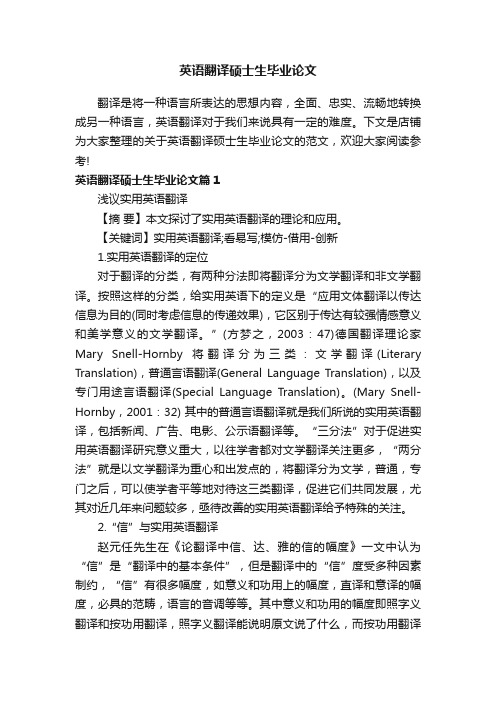
英语翻译硕士生毕业论文翻译是将一种语言所表达的思想内容,全面、忠实、流畅地转换成另一种语言,英语翻译对于我们来说具有一定的难度。
下文是店铺为大家整理的关于英语翻译硕士生毕业论文的范文,欢迎大家阅读参考!英语翻译硕士生毕业论文篇1浅议实用英语翻译【摘要】本文探讨了实用英语翻译的理论和应用。
【关键词】实用英语翻译;看易写;模仿-借用-创新1.实用英语翻译的定位对于翻译的分类,有两种分法即将翻译分为文学翻译和非文学翻译。
按照这样的分类,给实用英语下的定义是“应用文体翻译以传达信息为目的(同时考虑信息的传递效果),它区别于传达有较强情感意义和美学意义的文学翻译。
”(方梦之,2003:47)德国翻译理论家Mary Snell-Hornby将翻译分为三类:文学翻译(Literary Translation),普通言语翻译(General Language Translation),以及专门用途言语翻译(Special Language Translation)。
(Mary Snell-Hornby,2001:32) 其中的普通言语翻译就是我们所说的实用英语翻译,包括新闻、广告、电影、公示语翻译等。
“三分法”对于促进实用英语翻译研究意义重大,以往学者都对文学翻译关注更多,“两分法”就是以文学翻译为重心和出发点的,将翻译分为文学,普通,专门之后,可以使学者平等地对待这三类翻译,促进它们共同发展,尤其对近几年来问题较多,亟待改善的实用英语翻译给予特殊的关注。
2.“信”与实用英语翻译赵元任先生在《论翻译中信、达、雅的信的幅度》一文中认为“信”是“翻译中的基本条件”,但是翻译中的“信”度受多种因素制约,“信”有很多幅度,如意义和功用上的幅度,直译和意译的幅度,必具的范畴,语言的音调等等。
其中意义和功用的幅度即照字义翻译和按功用翻译,照字义翻译能说明原文说了什么,而按功用翻译则是去做原文相同情境中要做的事。
他指出,同样一句话,按字面翻译和按同样情形下译入语国习惯说法来翻译,经常会出现两种截然不同的情况。
浅析翻译理论视角下的戏剧翻译研究论文

浅析翻译理论视角下的戏剧翻译研究论文戏剧翻译是翻译学领域中的一个重要分支,旨在将戏剧作品从一种语言转化为另一种语言,使不同文化和语言背景下的观众能够理解和欣赏原作的艺术魅力。
本文将从翻译理论的视角出发,对戏剧翻译的研究进行浅析。
一、翻译理论视角下的戏剧翻译戏剧翻译作为翻译学研究的重要内容,需要借助翻译理论的指导和支持。
翻译理论提供了关于翻译过程、翻译策略以及翻译效果评估等方面的理论框架,为戏剧翻译的实践提供了理论支撑。
1.等值理论根据等值理论,戏剧翻译应该尽可能地保持原作的内涵和外延,使译文能够传达与原作相近的意义和效果。
在戏剧翻译中,翻译者需要通过选择合适的词语和表达方式来实现等值翻译,以确保目标语言观众对原作的理解。
2.功能对等理论功能对等理论强调翻译的目标是在不同文化和语言背景下实现功能的对等。
在戏剧翻译中,翻译者需要根据目标语言观众的文化背景和审美需求,对原作进行适当的调整和改写,以确保译文在观众之间产生类似的艺术效果。
3.文化转移理论文化转移理论认为翻译是一种跨文化传播活动,不仅涉及语言的转化,还涉及文化元素的传递和转换。
在戏剧翻译中,翻译者需要通过恰当地转化文化元素和背景知识,使观众在不同文化背景下能够理解和接受原作的艺术魅力。
二、戏剧翻译的特点和挑战戏剧翻译与其他类型的翻译存在一些独特的特点和挑战,这些特点和挑战需要翻译者根据具体情况进行应对和处理。
1.多重语言要素戏剧作品中常常涉及多种语言要素,例如方言、外语等。
翻译者需要根据受众的背景和理解能力,决定是否保留原文中的多重语言要素以及如何进行翻译和标注,以平衡原作风格和目标语言读者的理解需求。
2.文化差异不同文化之间存在差异,这对戏剧翻译提出了一定的挑战。
翻译者需要在翻译过程中考虑到受众的文化背景,并寻找合适的方式来转化文化元素,以确保观众能够理解和接受译文。
3.口头语言和行为语言的转换戏剧作品中常常出现口头语言和行为语言的转换。
- 1、下载文档前请自行甄别文档内容的完整性,平台不提供额外的编辑、内容补充、找答案等附加服务。
- 2、"仅部分预览"的文档,不可在线预览部分如存在完整性等问题,可反馈申请退款(可完整预览的文档不适用该条件!)。
- 3、如文档侵犯您的权益,请联系客服反馈,我们会尽快为您处理(人工客服工作时间:9:00-18:30)。
中图分类号:学校代码:1877UDC:密级:公开中国地质大学江城学院学期论文解释学翻译下的理论研究The Theoretical Study to Hermeneutics论文作者姜婷指导教师王伟老师学科专业英语专业研究方向翻译理论与实践班级名称翻译1 班学生学号 4120090114中国地质大学江城学院二○一一年十一导读解释学(Hermeneutics)的名字来源于希腊神话中的信使赫尔墨斯(Hermes),他主要的任务就是,把神旨传递并翻译给人间,在传递和翻译间有必要做一些解释的工作。
解释学在西方有着悠久的历史,代表人物有施莱尔马赫,海德格尔,加尔默尔,斯坦纳等人。
在19世纪,施莱尔马赫提出了“普遍解释学”的构想,使理解和解释主体化,海德格尔认为理解,有所谓的“前结构”主观的,且理解本身具有历史性,取决于观者先前的理解,因此理解要以“前理解”和“前结构”为前提。
20世纪以后,基于海德格尔思想的基础,伽达默尔在《真理与方法》(Truth and Methods)中提出“理解的历史性”,“视界融合”和“效果历史”三大哲学阐释学原则。
以海德格尔的释义思想为基础,斯坦纳把哲学、语言学、诗学、文学批评和文化史学的理论应用于对语言的解释,阐述的重点落在翻译这个中心问题上。
从阐释学角度来看,斯坦纳最为引人注目之处是提出了“理解也是翻译的观点”,他认为,无论语内翻译,语际翻译或符号学翻译都是不同形式的翻译,作为人类最基本的交流活动,它的最大特点在于理解。
可以看出解释学在发展过程中逐渐由最初的理论变得体制化,虽然每种翻译思想都存在自己的局限性,但不可否认它们极大的推动了解释学的发展。
关于解释学的研究仍在继续,以期将其完善。
本文总共分为四个部分,首先介绍了解释学的定义及开端,从中我们可以了解到解释学的由来和它早期的发展,其次对施莱尔马赫,海德格尔,加尔默尔,斯坦纳四个人各自的翻译理论分别作了详细的介绍,从中我们能很明显的看到他们各自理论的特色,并能在脑海中形成鲜明的对比,并能很清晰的看到解释学理论的被发展,再次提到了解释学理解观与翻译研究,从中可以意识到在翻译中理解的重要性,Content1. Introduction (4)2.The relevant view of Hermetical theory (5)2.1The translational ideas of Schleiermacher (5)2.2 The translational ideas of M.Heidegger (5)2.3The translational ideas of Hans-Georg Gadamer (6)2.3.1 The understanding of the historic (6)2.3.2 Fusion of horizons (6)2.3.3 Effect of history (7)2.4 George Steiner‟s translation model of hermeneutics (7)3.The concept of hermeneutic and translation research (9)4.Conclusion (10)Reference (10)1. IntroductionHermeneutics is also known as interpretation of aesthetics, and it is developed on basis of the phenomenology and existentialism developed on the basis , the basic characteristics of modern hermeneutics is objectivism. Hermeneutics is a philosophy of interpretation and understanding of technical text, it may be described as an interpretation of the theory and to understand the text according to the text itself, emphasizing the true objectively grasp the intention the text and the author.Hermeneutics is a subject about understanding, interpretation and other methodology of the discipline,It is the first text to explore the meaning of words or works, in particular, to establish "God's words' meaning. Generally considered herme--neutic can be traced back to ancient Greece from the etymology of the literature, which is mainly used during the hermeneutics logic surgery and forensics, as well as some religious and literary classic interpretation of the text it is designed to eliminate ambiguity and misconception. In Middle Ages hermeneutics became a branch of "the Bible" research, during the Renaissance and Reformation the research of the hermeneutics no longer stickled to religious classics, but extended to the interpretation of the whole classical culture .Hermeneutics has experienced two major breakthroughs for the first time in 18-19th centuries, German religious philosopher F. Schleiermacher based on different areas of the ideas of hermeneutics .Through the interpretation of the syntax and of the psychological made the classic hermeneutics systematic, and made it become a general hermeneutics with methodological characteristics . And life philosopher W. Dilthey started from the "Historical Critique" program to expand the scope of the study of the hermeneutics ,and make a tight system of natural science. The second breakthrough occurred in the 20th century, two German philosophy, Martin Heidegger and Hans-Georg Gadamer realized the transform from epistemology to ontology, the establishment of the interpretation learning as a core philosophy to understand the independence of the Hermeneutics and push it into the prosperous. To the late 1960s, hermeneutics mainly related to the understanding , the meaning and the relationshipbetween the reader and the text and other issues. British translation theorist George Steiner was the first one to use the theory into translation studies in his book "After Babel: Aspects of Translation and Language" , thus establishing a close relationship between translation and interpretation .2.The relevant view of Hermetical theory2.1The translational ideas of SchleiermacherIn explaining the process of understanding Schleiermacher said, "If words could not be understood as a relationship of language, then it will not be understood as the spirit of the fact because of the inherent spirit "language, so it must be explained from the syntax. He presented his view of translation in the book "On the translation method," he thought that this problem of translation can be solved in two ways: First, try not disturb the tranquility of the original author , so readers can get close to the author (alienation) Second, try not to disturb the tranquility of the reader, so close the reader to the author (accommodation)He divided the translation into translation and interpretation: translators are mainly engaged in the field of science and art of translation; interpreters are mainly on the translation of commence.Also it was divided into the real translation and machine translation: real translation mainly refers to the natural sciences, literature and translation; machine translation refers to the practical translation .These arguments undoubtedly left a lot of space for the later generation to continue the study, and greatly enriched the idea of translation theory. from both the depth side and breadth side.2.2 The translational ideas of M.HeideggerHeidegger thought that the task of philosophy is to show how the theme is to build reasonably to aware the certainty of the specification, which determine whether a given representation is true or false. From this position, he continued, the truth is not long offered only by means of natural science concepts. However, such a model, often forget the most fundamental, the world's top science we are. This is Heidegger' s interpretation of the field. Therefore, philosophical hermeneutics is no longer a possibility of one of the few. On the contrary, hermeneutics hermeneutics of authenticity, as Heidegger said, it is philosophy, and it is in the first place. This reflects Heidegger' s understanding, interpretation, and asserted, such as definitions of terms. Understanding, in Heidegger' s account, which is neither a method of reading, nor is the will and well-conducted process of critical reflection of the results. This is not what we consciously do or not do something, but our stuff. Understanding is that existing models, so it is a human characteristic.This occupied the world in which the first way is itself a reflection of the nature of hermeneutics. We understand the premise of the world, reveals the way, we do not have theoretical considerations, apractical know-how, we are in the East. We opened the door, there is no objective or concept to determine the nature of a door handle or door frame. The world is a basic, intuitive way we familiar with. Most of the first, Heidegger believes that we do not understand a collection of neutral facts makes it possible to achieve universal ideas, laws or decisions, large or small extent, corresponding to the world, because it is through the collection of the world. The world is tacitly understood.2.3The translational id eas of Hans-Georg GadamerAs the translation is the interpretation and understanding to the original text, highly subjective interpretation of the translation process research must locate the translator, and gives the translator the initiative to the understanding and interpretation of the text. After the 20th century, based on Heidegger‟s idea, Gadamer referred t o three philosophy principles: in "Truth and Methods "understanding of the historic", "fusion of horizons" and "effect of history". Especially, the "fusion of horizons” improved the interpreter's initiative and creativity to unprecedented heights.2.3.1 The understanding of the historicGadamer thought hat understanding is historic, understanding of the historic constitute the prejudice of understanding, thereby determining the creative and generative the understanding. Real understanding is not to overcome the limitations of history but to properly evaluate and adapt to it, in this sense, understanding of the text is no doubt a historic. Either a translator will be subject to a variety of subjective or objective historical conditions, the absolute "trust" can not exist. Misreading is the historic understanding which has been recognized by the times, and it is also the production affected by the existing social factors and the values before the understanding. For example, the late Qing period, facing the foreign powers invasion, alien domination, the Patriots gave full play to political enlightenment function the novel's literary, and many those had no political color or a lighter color of the foreign political novels were added "political reading" when they were translated and introduced to China, and take up a political mission. The understanding of the historical led to the bias of understanding, including misreading phenomenon, but Gadamer thought that this bias is "legitimate", he affirmed this "legitimate prejudice" constitute the historical factors of understanding. Gadamer‟s discourse to the positive bias makes us realize the significance of the misreading ,the denial and blame should not given to misreading, we need to re-examine its value.2.3.2 Fusion of horizonsUnderstanding existed in the means of the historical, whether the subject -------knower- or the object------ text all historically existed, and both have their own horizon. Horizon refers to the starting point of understanding, perspective and possible prospects. Two kinds of event horizon exist gaps, the gap caused by thechange of space and history of this scene can not be eliminated by any person. Madame claimed that the two kinds of vision should be blended together during the process of the understanding to achieve "fusion of horizons", so can make the knowers and understood objects surpass the original understanding of the event horizon, to achieve a new vision. His fusion of horizons has revealed the concept of translation, literary translation, especially in real terms, that is, in translation, the translator should strive to close to the initial vision of the original author ,then comprehended the author's intention.2.3.3 Effect of historyThe knowers and understood objects are all the existence of the history, the understanding and the meaning of the text were formed together in a constant process, Hans-Georg Gadamer called the history of this process "effect of history."To understand the works in the effect of history. Gadamer' s hermeneutics is a basic principle, he believes that "art works are the works including the effect of history ," and pointed out that the text is open, its significance can never be exhausted, so it is beyond the era that produced it, which provided for the possibility of understanding it for people of different times , in this sense, literary classics retranslation should be worth encouraging, Mr. Lu claimed that even if there is good translation, retranslation is still necessary , and even a near-final version in full, will change because of a new era of re-translation. Meaning of work is diverse, but a translation is fixed historical, cultural, temporary product. Human constantly surpassed themselves in the understanding it, are constantly re-writing their own history in the renewal and development of the "effect of history", and re-reflect on themselves and their own culture.Gadamer emphasized the ontological status of artistic truth, aesthetic understanding is the understanding of the truth of art and the world body, art works as the object to the understanding to the beauty is actually open, on the one hand, the most artists speak directly to us, there is a mysterious intimacy that we feel with the integration of the arts as a whole, on the other hand, we continue to see themselves from the art, as if we face to face with ourselves2.4 George Steiner’s translation model of hermeneuticsBased on interpretation of Heidegger' s thinking, the Steiner applied the philosophy, linguistics, poetry, literary criticism and cultural history of the theory to the interpretation of language ,and its focus falls on the translation of this central issue. From the hermeneutic point of view, the most striking is that Steiner proposed a "point of view to understanding is the translation "and steps to the interpretation of translation has particular characteristics, which includes :”Understanding as Translation” The concept of Seiner's translation has a broad sense,including “intralingual translation”. “interlingual translation”and “inter semiotic translation”,which is same to the linguists Jacobs Johnson's reference. Not only across different symbol systems and language translation between interlingual translation is difficult, and in the same language, the translation of the dialect and common language between the old saying and modern language is not very easy, the difficulty lies in understanding. He believes that the production of language and the process understanding is actually the translation process. Translation is the basis of language, while the translation is based on the existence of language as a whole.The hermeneutical steps constitutes the core of Stenior …s theoretical description , which is divided into four parts: trust ,aggression, incorporation, and compensation .(1) TrustThe so-called trust is based on past experience, the reader believe that the original work is serious, meaningful values ,so it must be understood thoroughly, otherwise it dose not have to translate. All translation activities have started from the trust,and the trust is based on the original two sides, partly from experience, the other is the theory. The translator's first action is "a belief that investment," which lies in the belief and trust that something original is understandable.(2) AggressionThe captured interpreted can bu thought as the conflict between two languages, two forms of conflict in the translator‟s intuition , this is a"offensive, strong and aggressive “ action. This violent of Steiner' s understanding from Heidegger can find a theoretical basis from Heidegger ,and specifically refers to the invasion of the original translator, the original text to be understood.(3)AbsorptionAbsorption means that the translator absorbs the original meaning, which inject new vitality into translation. This is the first step the results achieved, including the original meaning and form of naturalization must be transplanted into the target language, target language should embody all the information reflects the original works. Steiner saw the following two extremes as a "complete return" First, the purpose of the target text completely archived classic status, or " always maintain the strange and edge position forever."(4) CompensationThe compensation means compensating for the lost in the translation process ,namely return the things that the original to the original place, the complete four steps of translation must end with"compensation" Steiner pointed out that in the translation the translator's aggressive diversion of the original meaning of the merger will inevitablyresult in the loss of all aspects of the original works, so the translator must try to "make up in order to restore the balance between the original and translated."3.The concept of hermeneutic and translation researchTranslation is the interpretation and understanding of the original text ,the process of the hermeneutic is very subjective, and is generated by the reader through the text of an intermediary in the process of dialogue with the author-generated, but also generated in the main interaction between Interpretation of Marxism. The concept of translation thought that the translator is not a passive recipient of the text, but the process of actively creating the text, the translator must explore thinking process and track of the original author, and grasp the "pre-structure" of the text . The interpretation in translation is that the critic and interpretation is based on the translator‟s understanding to the original text , and is the psych ological process that the translator experienced before he resorted the target language to written expression ,and it is attached to understanding and express links.As we all know, any translation began with the understanding to the original text, and in hermeneutic theory made a very important point worthy with the translation researcher‟s attention from the very beginning, Hans-Georg Gadamer said: "Understanding is a thing which we are involved in it but can not control, it is a thing fallen on us . we never empty-handed enter into the realm of understanding,but always carrying a lot of familiar beliefs and expectations. The understanding of Hermeneutic includes both the strange world we suddenly encounter and the familiar world which we have. "This view is used in translation, and will the translator‟ s awareness and understanding in the process of the Hermetic, but if you ignore this factor it is easy to understand the deviation caused by translation and misunderstanding. for example, the contemporary translation, the translator of "Journey to the West" mistakenly translated a character "barefoot" as red-legged immortal, which is clearly based on the way to understand the English language and only understand "red" in the Chinese understand become "red"in the english, but do not know "red" in the Chinese language also means "light, bare".Philosophical Hermeneutics of Translation Studies has a comprehensive and profound influence to the study of translation, if most of the major theoretical did not have the use of philosophical hermeneutics, we may not get a reasonable explanation. So that the translation is no longer a mechanical conversion of the language level, translation studies are also not only analysis and application to the text.4.ConclusionFrom the above study, we can learn that the scientists of the hermeneutic interpretation of are on hold a positive attitude.Schleiermacher referred to accommodation and alienation, and made distinction between translation and interpretation, the real translation and machine translation.Heidegger believed that understanding is subjective, and understanding has its own historic , depending on the viewer's understanding of the previous, there is so-called "pre-structure" and therefore should understand the "pre-understanding" and "pre-structure" as a precondition. Da Moet referred to three principles of hermeneutics in "Truth and Method" :"understanding of the historic", "fusion of horizons" and "effect of history" .The most striking that Steiner made is "Understanding is the translation of ideas."These views have their own translation characteristics and their values, during their own period ,they all have pushed the development of hermeneutic ,and we can still find that those translation ideas have developed from step by step ,and have gradually become systemically ,although they inevitably have their own objectivity and limitations, but it is undeniable that they injected new ideas for the hermeneutics. Knowledge is endless, only by continues study and research can we make a progress.So we not only need to learn from the experience and study of previous people,but also need to explore this field and improve the hermeneuticsReference1.Ferguson, Sinclair B; David F Wright, J. I. (James Inn ell) Packer (1988). New Dictionary of Theology. Downers Grove, Ill.: Inter Varsity Press.2.Girondin, Jean (1994). Introduction to Philosophical Hermeneutics. Yale University Press.3. Cozen-Hoy, David (1981). The Critical Circle. University of California Press. ISBN0-520-046394.Bjork Bamberg Kristin Ivesdale. "Hermeneutics". Stanford Encyclopedia of Philosophy./entries/hermeneutics/. Retrieved 2007-12-04.5 Martin Jan Mulder, ed., Mikra: Text Translation, Reading and Interpretation of theHebrew Bible in Ancient Judaism and Early Christianity(Minneapolis: Fortress Press, 1990), 743.6. Belding, Gerhard, The New Hermeneutics and the Early Luther, page 387. Forster, Michael. "Friedrich Daniel Ernst Schleiermacher". Stanford Encyclopedia ofPhilosophy. /entries/schleiermacher/.9.Reeves, Byron & Clifford Nass (1996). The Media Equation: How People TreatComputers, Television, and New Media Like Real People and Places. CSLI Publications and Cambridge University Press. p. 30110.Heidegger, Martin (1927/1962). Being and Time. Harper and Row. p. H12511.Jones, L. 2000. The Hermeneutics of Sacred Architecture: Experience, Interpretation,Comparison, p.263;V olume Two: Hermeneutical Calisthenics: A Morphology of Ritual-Architectural Priorities, Cambridge Mass.: Harvard University Press12. Vestally, D. 2004. Architecture in the Age of Divided Representation: The Question ofCreativity in the Shadow of Production, Cambridge, Mass.: MIT Press.13.Boyne, R. 1995. Designing Information Technology in the Postmodern Age: FromMethod to Metaphor, Cambridge, Mass.: MIT Press.14.David L. Bennie (2007). "Hermeneutics and Humanistic Psychology". The HumanisticPsychologist /divisions/div32/pdfs/hermeneutics.pdf. Retrieved 2009-07-07.。
